Factors Shaping A/W Heat Pumps CO₂ Emissions—Evidence from Poland
Abstract
1. Introduction
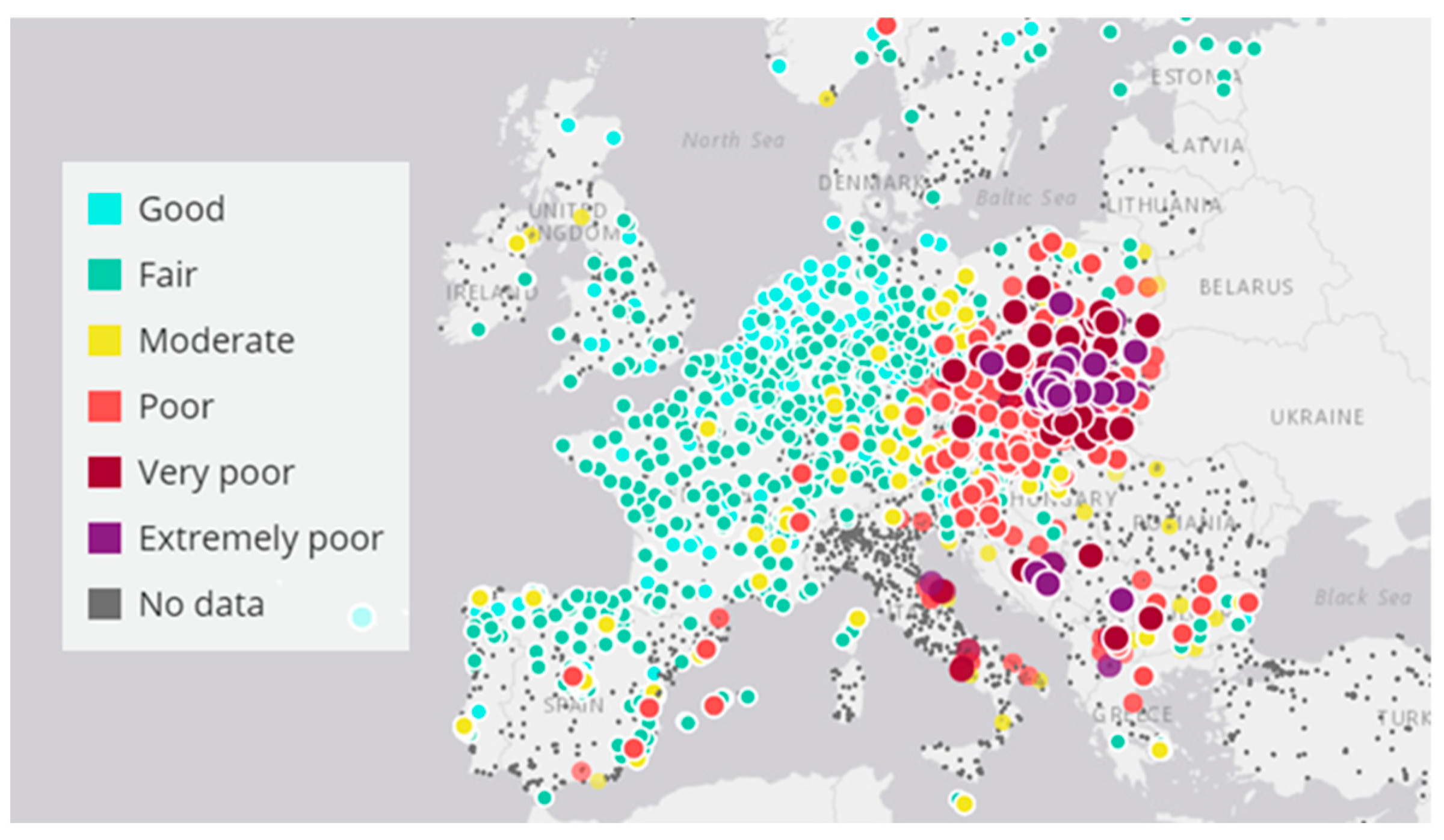
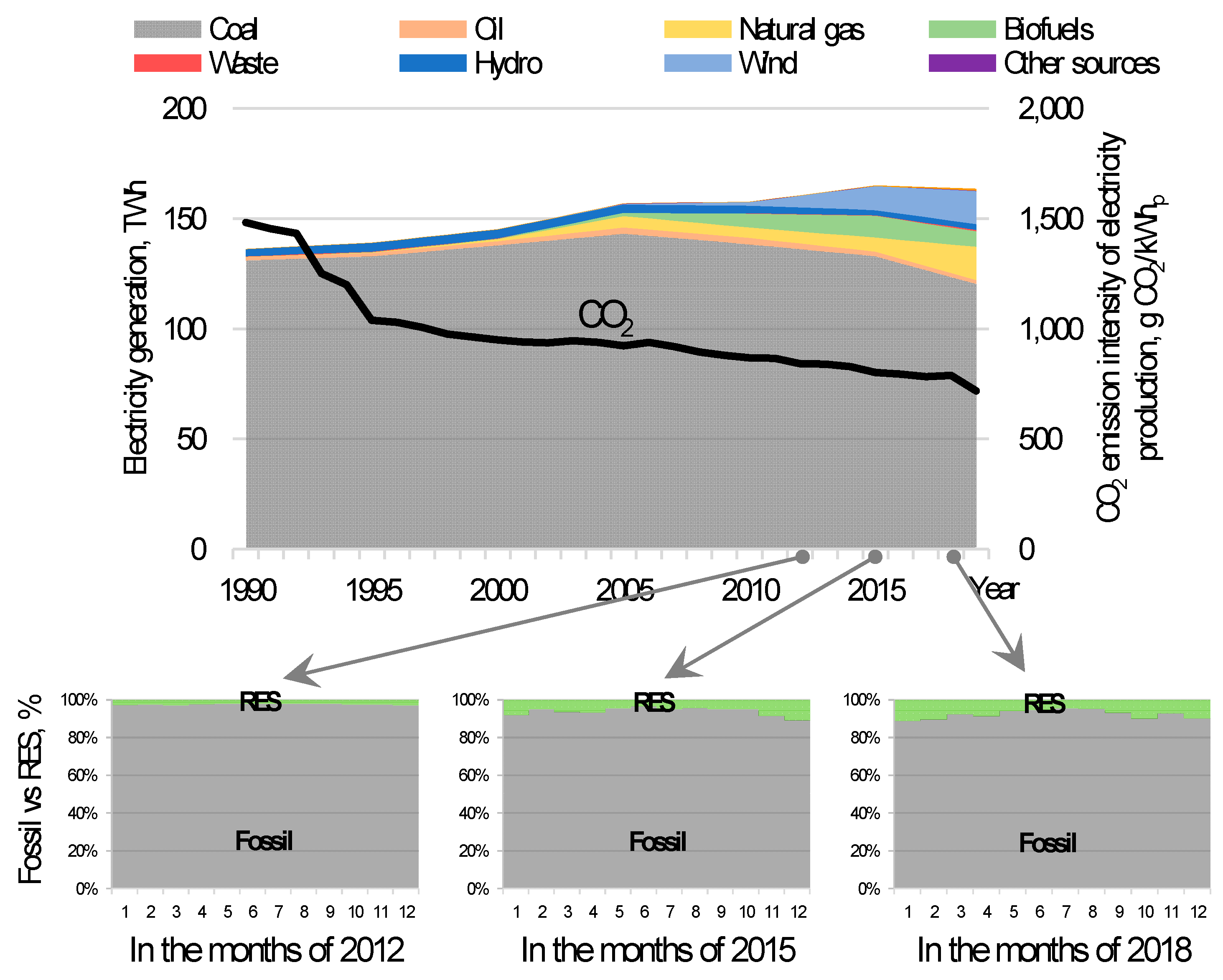
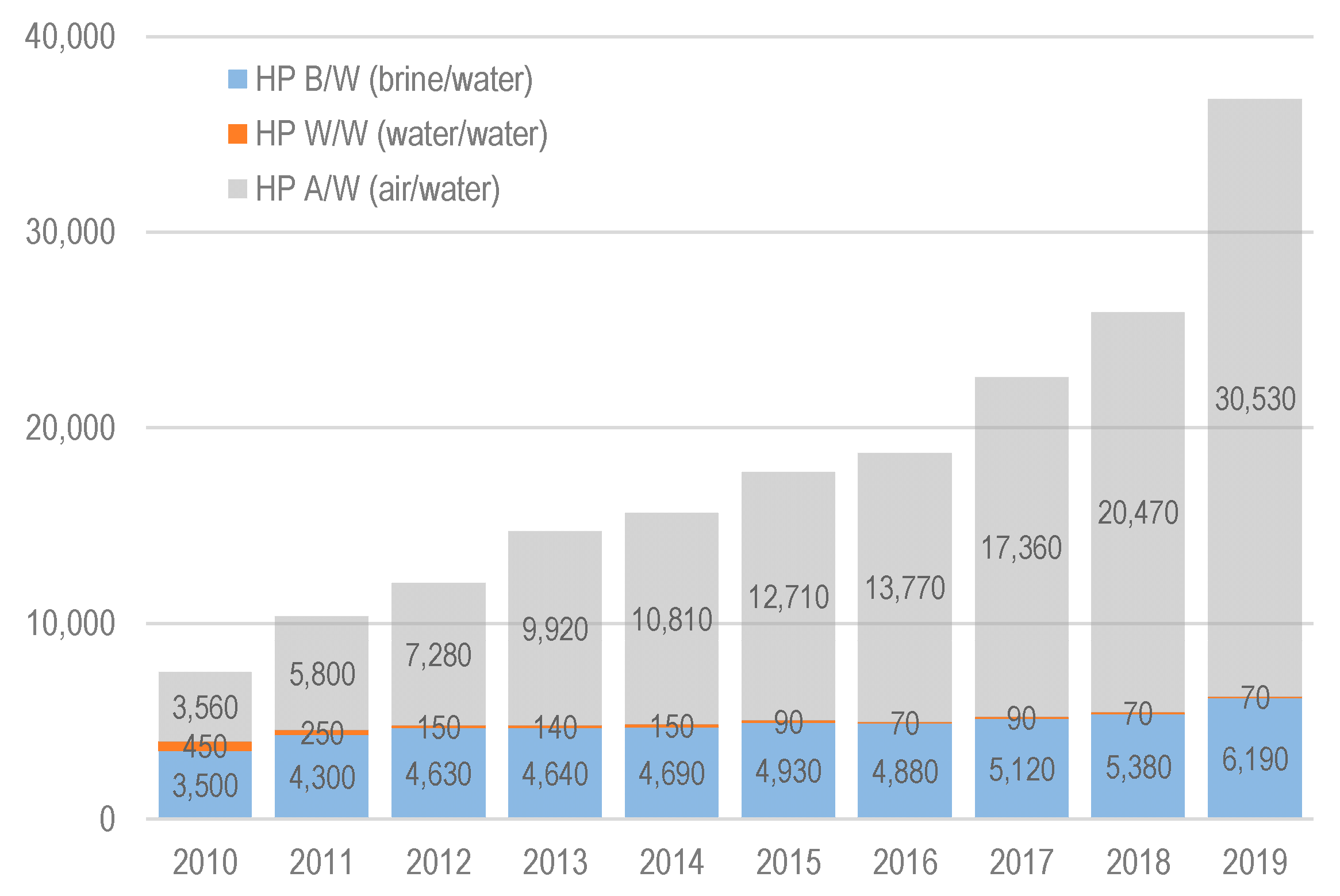
- Do heat pumps in the context of the present Polish power system support the process of heating sector decarbonization and achieving EU targets?
- What is the main factor shaping heat pump-derived heat emissivity? Is it climate change, technology progress or the power system energy mix?
2. Data and Methods
2.1. Alternative Scenarios
- ■
- Scenario S0 presents the semi-real 1995–2019 heat pump CO₂ emission intensity (EIHP) calculated based on three main factors: inventoried CO₂ emission intensity of electricity production (EIE), historical coefficient of performance (COP) and global warming represented by ambient air temperature (te). The S0 scenario assessed the synergy of climate change, historical technology improvement and power sector decarbonization and estimated the potential benefits.
- ■
- In scenario S1, the power sector’s CO2 emission intensity (EIE) was fixed at the 1995 level. The 1995–2019 tendency of heat pumps’ CO2 emission intensity (EIHP) was calculated with historical COP and recorded ambient air temperature (te) reflecting the influence of actions independent of or lack of development in power sector technology and no changes in fuel mix.
- ■
- In scenario S2, the heat pumps’ coefficient of performance (COP) was fixed at the 1995 value. The calculated CO2 intensity of heat pumps reflects two different situations. First, the emission effect of a heat pump installed in 1995 operating on the recorded ambient air temperature (te) and powered by electricity with historical CO2 emission intensity changes (EIE). Finally, the lack of progress in heat pumps technology was simultaneously determined.
- ■
- In scenario S3, the ambient air temperature (te) impacting the heat pump COP was fixed at the 1995 value. The CO₂ emission tendency followed the real 1995–2019 changes in power sector emission intensity and technological development of heat pumps. The S3 scenario demonstrates the influence of factors other than ambient air warming as a hypothetical value that could have been achieved if the goals relating to climate change had been implemented earlier. Simultaneously, it includes the consideration of only direct influence factors displaying the results of active improvement.
2.2. Input Datasets
2.2.1. CO2 Emission Intensity of Electricity Production EIE
2.2.2. Heat Pumps Coefficient of Performance COP
2.2.3. Ambient Air Temperature te
2.3. CO₂ Emission Intensities of Heat Pumps
- COP—heat pump coefficient of performance;
- te—average annual (domestic hot water variant) or seasonal (space heating variant) ambient air temperature, °C;
- EIHP—CO2 emission intensities of heat pump per unit of produced thermal energy, g CO2/kWhth;
- EIE— CO2 emission intensity of electricity production EIE per unit of generated power, g CO2/kWhp;
- i—year;
- j—operation mode in analyzed scenario.
3. Results and Discussion
4. Conclusions
Author Contributions
Funding
Institutional Review Board Statement
Informed Consent Statement
Data Availability Statement
Conflicts of Interest
References
- Lund, H. Renewable heating strategies and their consequences for storage and grid infrastructures comparing a smart grid to a smart energy systems approach. Energy 2018, 151, 94–102. [Google Scholar] [CrossRef]
- Pezzutto, S.; De Felice, M.; Fazeli, R.; Kranzl, L.; ZambottI, S. Status Quo of the Air-Conditioning Market in Europe: Assessment of the Building Stock. Energies 2017, 10, 1253. [Google Scholar] [CrossRef]
- European Commission. Heating and Cooling. 2021. Available online: https://ec.europa.eu/energy/topics/energy-efficiency/heating-and-cooling_en (accessed on 18 February 2021).
- Bertelsen, N.; Vad Mathiesen, B. EU-28 residential heat supply and consumption: Historical development and status. Energies 2020, 13, 1894. [Google Scholar] [CrossRef]
- Jones, L.E. Renewable Energy Integration: Practical Management of Variability, Uncertainty, and Flexibility in Power Grids; Academic Press: Cambridge, MA, USA, 2017. [Google Scholar]
- Delucchi, M.A.; Jacobson, M.Z. Providing all global energy with wind, water, and solar power, Part II: Reliability, system and transmission costs, and policies. Energy Policy 2011, 39, 1170–1190. [Google Scholar] [CrossRef]
- Ramsebner, J.; Haas, R.; Ajanovic, A.; Wietschel, M. The sector coupling concept: A critical review. Wiley Interdiscip. Rev. Energy Environ. 2021, 396. [Google Scholar] [CrossRef]
- European Environment Agency. European Air Quality Index (WWW Database). 2020. Available online: https://www.eea.europa.eu/themes/air/air-quality-index (accessed on 18 February 2021).
- International Environment Agency. Electricity Information (WWW Database). 2020. Available online: https://www.iea.org/data-and-statistics?country=WORLD&fuel=Energy%20supply&indicator=TPESbySource (accessed on 18 February 2021).
- European Environment Agency. Greenhouse Gas Emission Intensity of Electricity Generation. (WWW Database). Available online: https://www.eea.europa.eu/data-and-maps/daviz/CO2-emission-intensity-6#tab-chart_2_filters=%7B%22rowFilters%22%3A%7B%22ugeo%22%3A%5B%22Poland%22%5D%7D%3B%22columnFilters%22%3A%7B%7D%7D (accessed on 18 February 2021).
- Krajowe Sieci Elektroenergetyczne. Raport 2019 KSE. Zestawienie Danych Ilościowych Dotyczacych Funkcjonowania KSE w 2018 Roku. Available online: https://www.pse.pl/dane-systemowe/funkcjonowanie-rb/raporty-roczne-z-funkcjonowania-kse-za-rok/raporty-za-rok-2018 (accessed on 18 February 2021).
- Krajowe Sieci Elektroenergetyczne. Raport 2015 KSE. Zestawienie Danych Ilościowych Dotyczacych Funkcjonowania KSE w 2018 Roku. Available online: https://www.pse.pl/dane-systemowe/funkcjonowanie-rb/raporty-roczne-z-funkcjonowania-kse-za-rok/raporty-za-rok-2015 (accessed on 18 February 2021).
- Krajowe Sieci Elektroenergetyczne. Raport 2012 KSE. Zestawienie Danych Ilościowych Dotyczacych Funkcjonowania KSE w 2018 Roku. Available online: https://www.pse.pl/dane-systemowe/funkcjonowanie-rb/raporty-roczne-z-funkcjonowania-kse-za-rok/raporty-za-rok-2012 (accessed on 18 February 2021).
- Bayer, P.; Saner, D.; Bolay, S.; Rybach, L.; Blum, P. Greenhouse gas emission savings of ground source heat pump systems in Europe: A review. Renew. Sustain. Energy Rev. 2012, 16, 1256–1267. [Google Scholar] [CrossRef]
- Gajewski, A.; Siergiejuk, J.; Szulborski, K. Carbon dioxide emission while heating in selected European countries. Energy Build. 2013, 65, 197–204. [Google Scholar] [CrossRef]
- Dzikuć, M.; Adamczyk, J. The ecological and economic aspects of a low emission limitation: A case study for Poland. Int. J. Life Cycle Assess. 2015, 20, 217–225. [Google Scholar] [CrossRef]
- Sewastianik, S.; Gajewski, A. Energetic and Ecologic Heat Pumps Evaluation in Poland. Energies 2020, 13, 4980. [Google Scholar] [CrossRef]
- Nemś, A.; Nemś, M.; Świder, K. Analysis of the possibilities of using a heat pump for greenhouse heating in polish climatic conditions—A case study. Sustainability 2018, 10, 3483. [Google Scholar] [CrossRef]
- Gajewski, A.; Gładyszewska-Fiedoruk, K.; Krawczyk, D.A. Carbon dioxide emissions during Air, Ground, or Groundwater heat pump performance in Białystok. Sustainability 2019, 11, 5087. [Google Scholar] [CrossRef]
- Hałacz, J.; Skotnicka-Siepsiak, A.; Neugebauer, M. Assessment of reducing pollutant emissions in selected heating and ventilation systems in single-family houses. Energies 2020, 13, 1224. [Google Scholar] [CrossRef]
- PORT PC. Rynek Pomp Ciepła w Polsce w 2019 Roku i w Perspektywie do Roku 2030. 2020. Available online: www.portpc.pl (accessed on 18 February 2021).
- Eschmann, M. Qualitätsüberwachung von Kleinwärmepumpen und statistische Auswertung; BFE: Bern, Switzerland, 2015. [Google Scholar]
- Institute of Meteorology and Water Management [WWW Database]. Available online: https://danepubliczne.imgw.pl/ (accessed on 18 February 2021).
- European Standard EN 255:2000. Air Conditioners, Liquid Chilling Packages and Heat Pumps with Electrically Driven Compressors. Heating Mode; European Standard: Pilsen, Czech Republic, 2000. [Google Scholar]
- European Standard EN 14511:2018. Air Conditioners, Liquid Chilling Packages and Heat Pumps for Space Heating and Cooling and Process Chillers, with Electrically Driven Compressors; European Standard: Pilsen, Czech Republic, 2018. [Google Scholar]
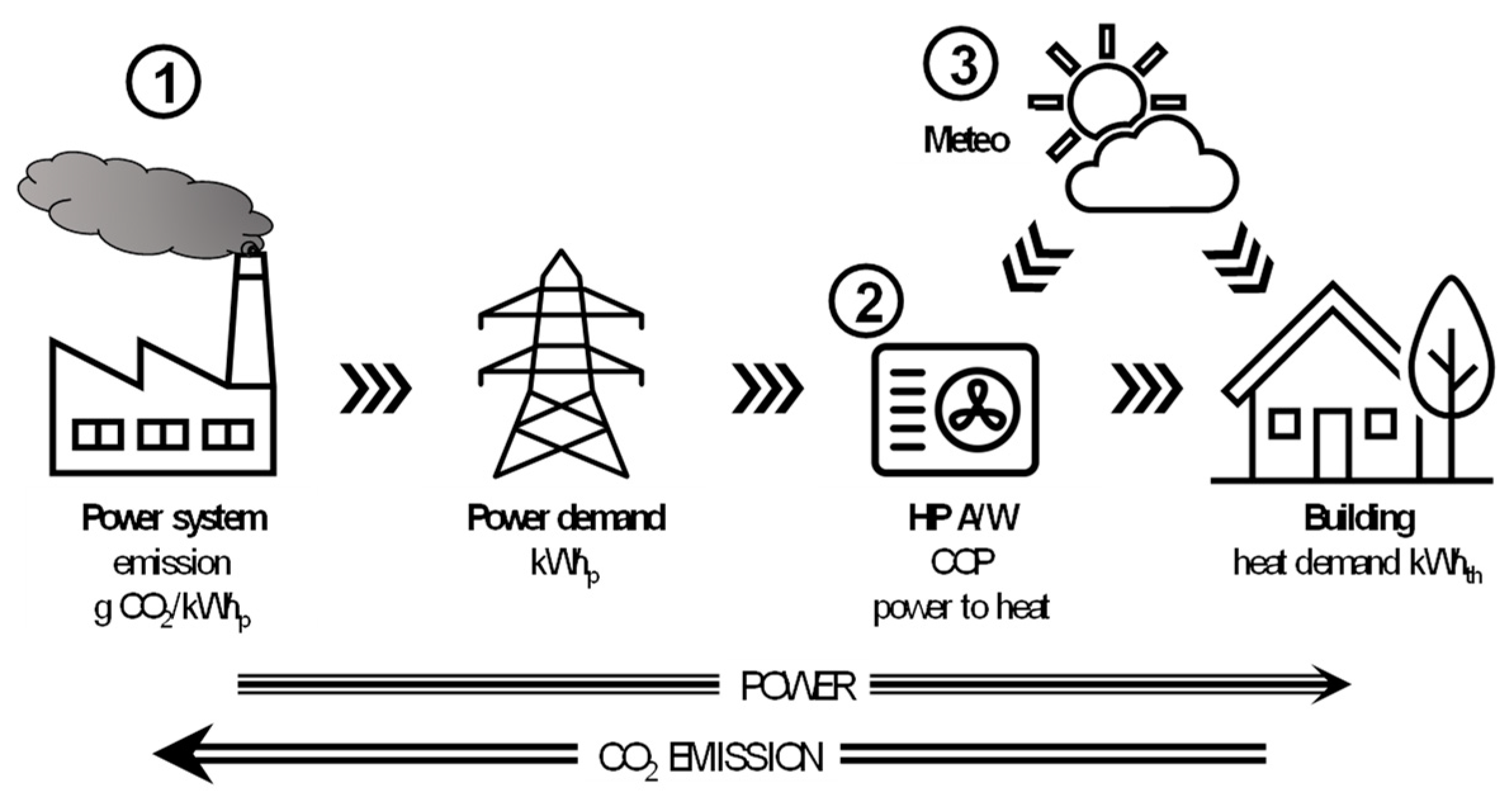

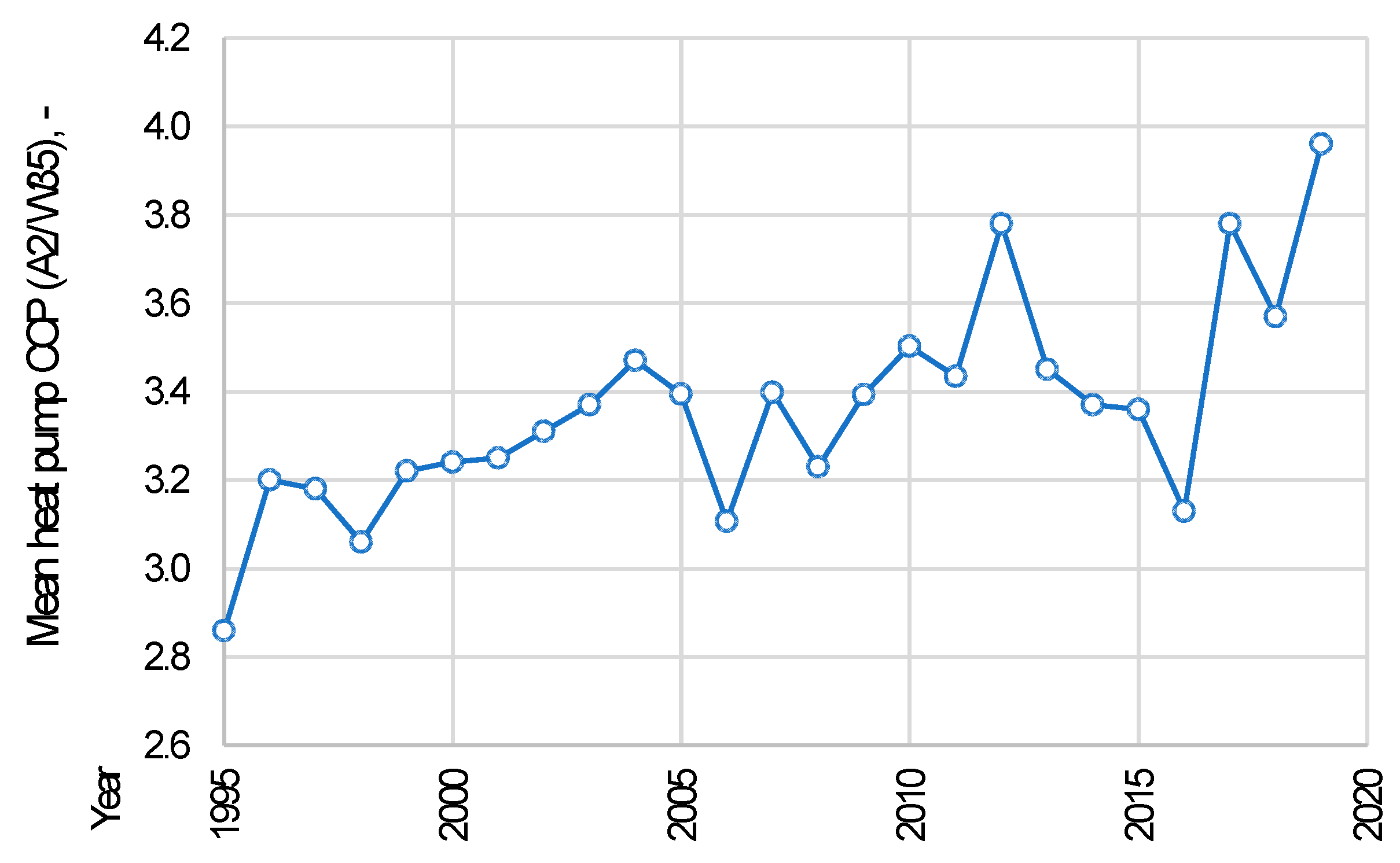
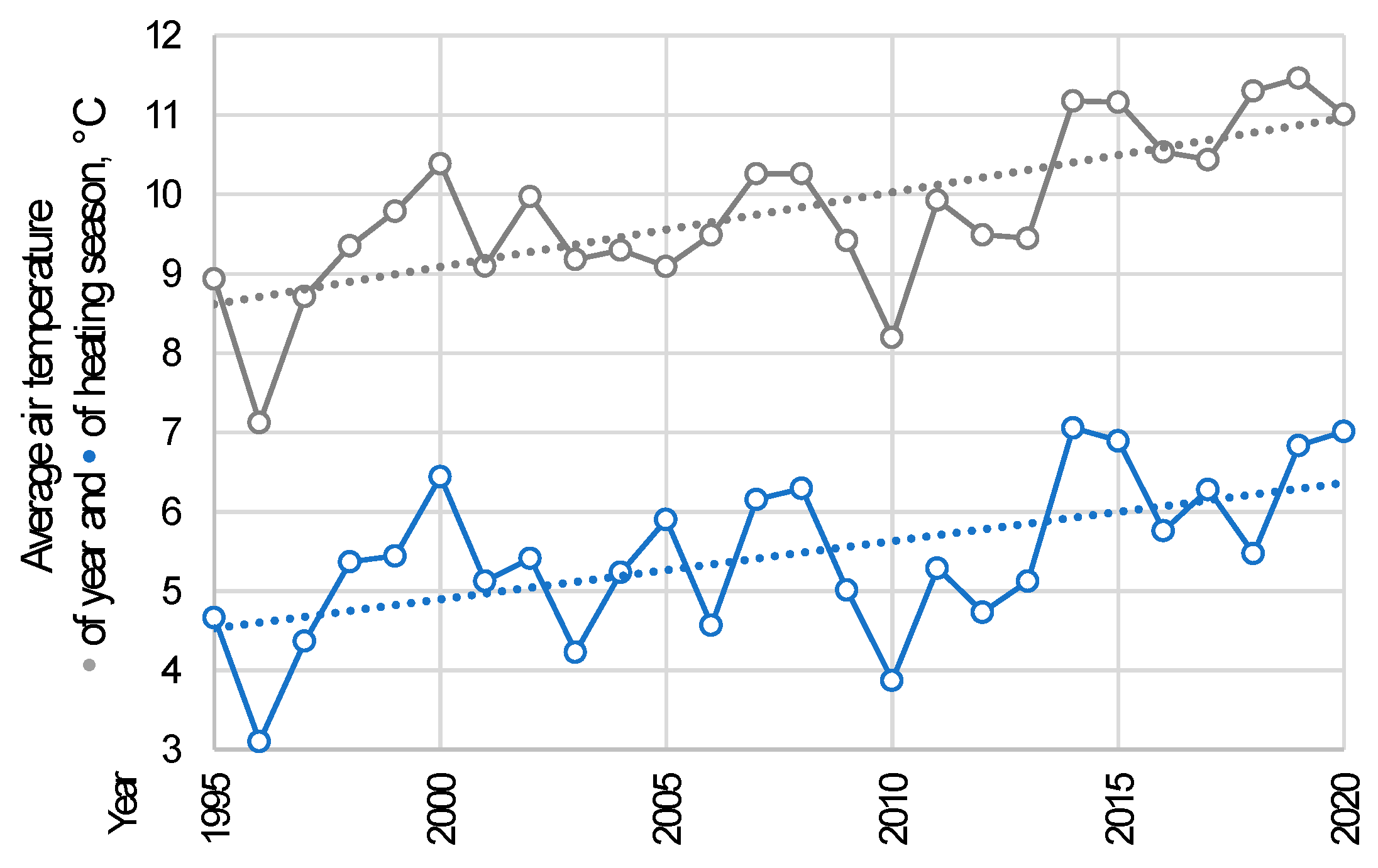
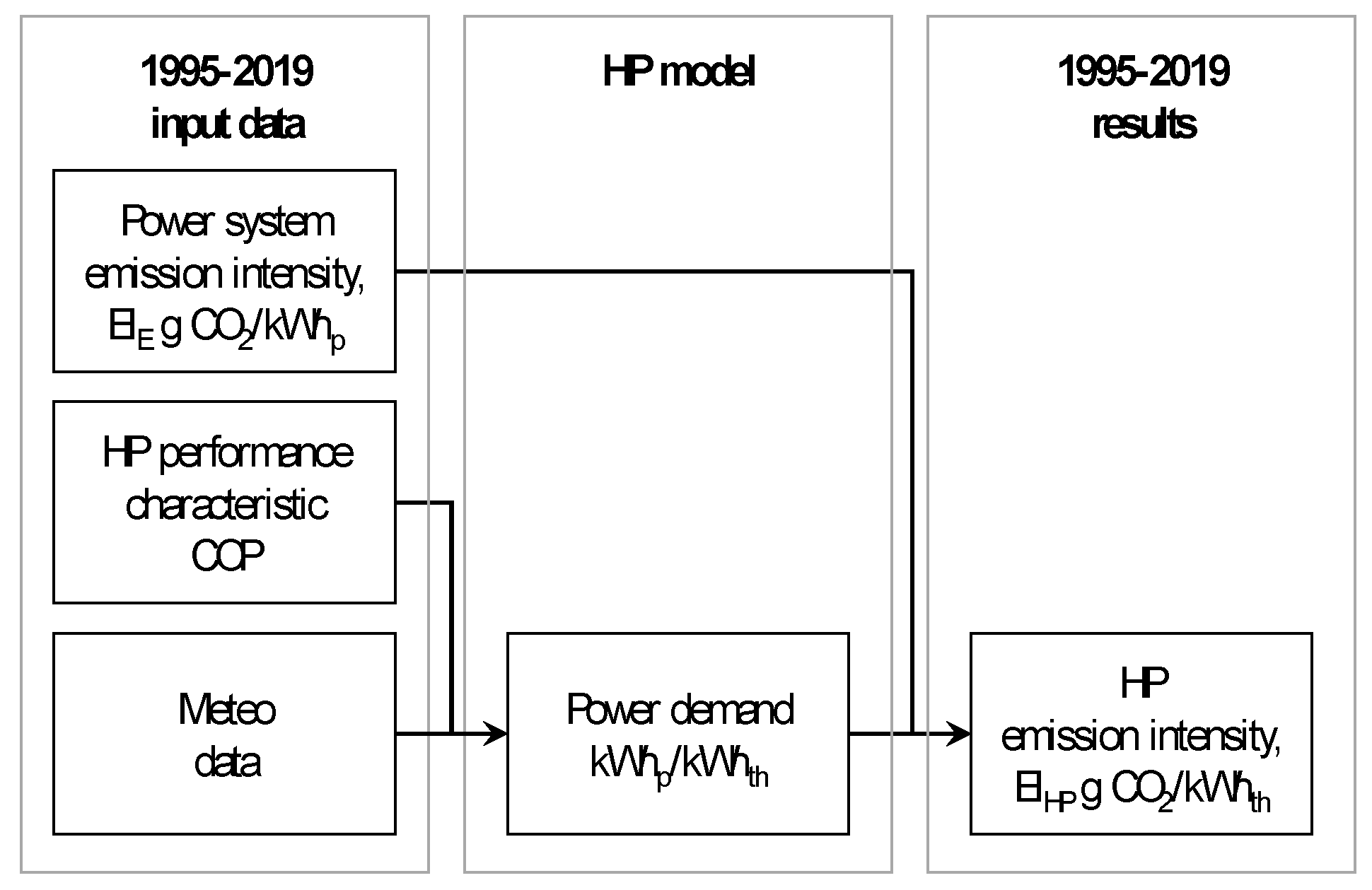
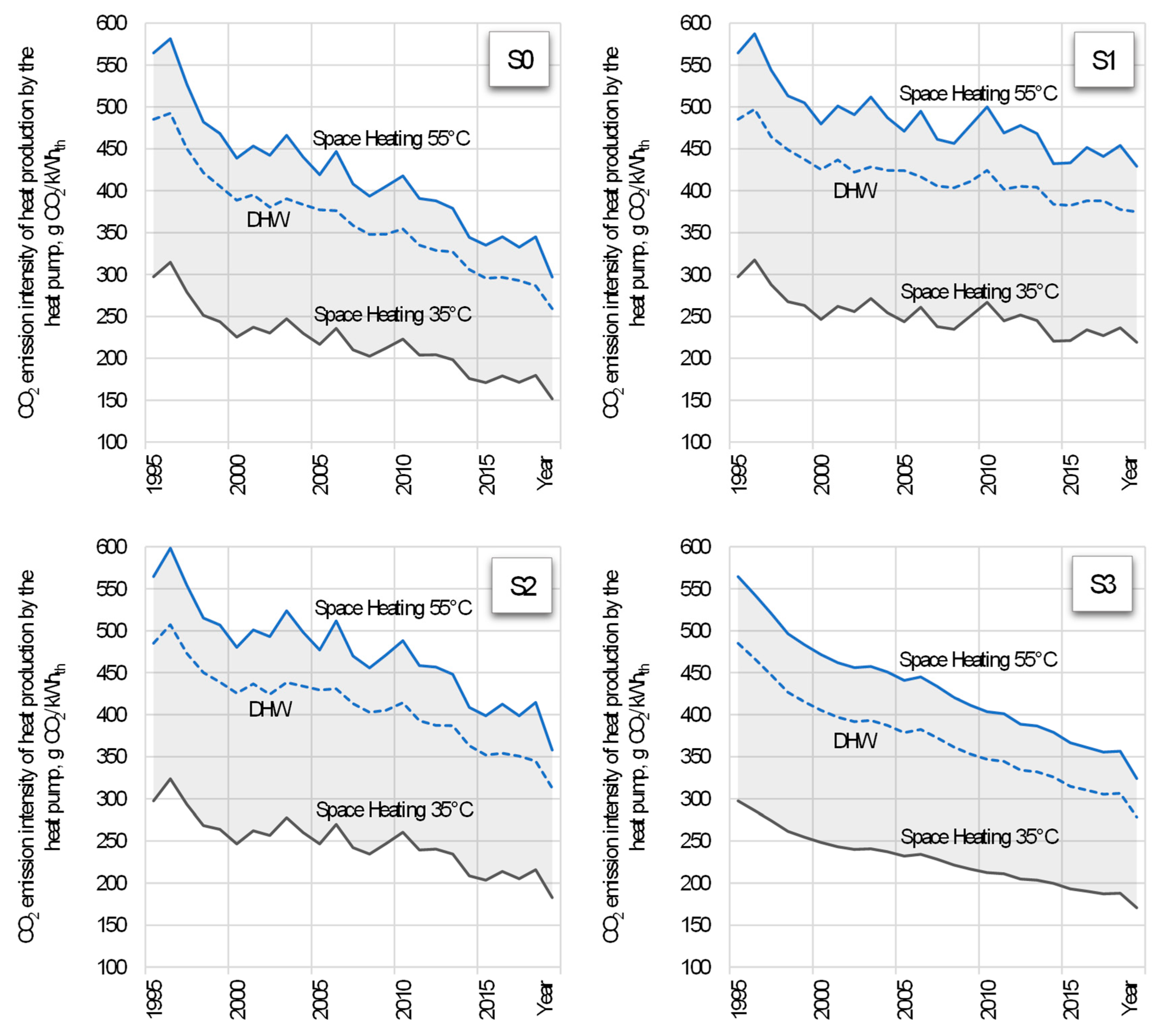
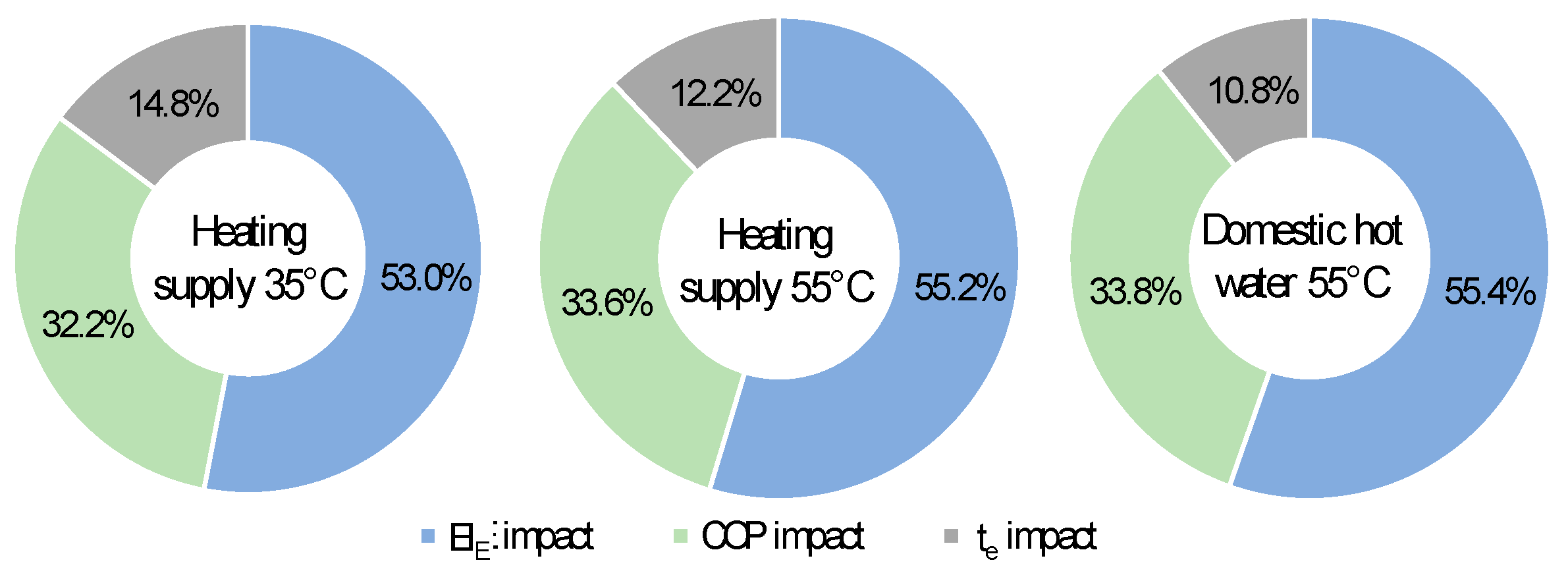
Publisher’s Note: MDPI stays neutral with regard to jurisdictional claims in published maps and institutional affiliations. |
© 2021 by the authors. Licensee MDPI, Basel, Switzerland. This article is an open access article distributed under the terms and conditions of the Creative Commons Attribution (CC BY) license (http://creativecommons.org/licenses/by/4.0/).
Share and Cite
Jadwiszczak, P.; Jurasz, J.; Kaźmierczak, B.; Niemierka, E.; Zheng, W. Factors Shaping A/W Heat Pumps CO₂ Emissions—Evidence from Poland. Energies 2021, 14, 1576. https://doi.org/10.3390/en14061576
Jadwiszczak P, Jurasz J, Kaźmierczak B, Niemierka E, Zheng W. Factors Shaping A/W Heat Pumps CO₂ Emissions—Evidence from Poland. Energies. 2021; 14(6):1576. https://doi.org/10.3390/en14061576
Chicago/Turabian StyleJadwiszczak, Piotr, Jakub Jurasz, Bartosz Kaźmierczak, Elżbieta Niemierka, and Wandong Zheng. 2021. "Factors Shaping A/W Heat Pumps CO₂ Emissions—Evidence from Poland" Energies 14, no. 6: 1576. https://doi.org/10.3390/en14061576
APA StyleJadwiszczak, P., Jurasz, J., Kaźmierczak, B., Niemierka, E., & Zheng, W. (2021). Factors Shaping A/W Heat Pumps CO₂ Emissions—Evidence from Poland. Energies, 14(6), 1576. https://doi.org/10.3390/en14061576








